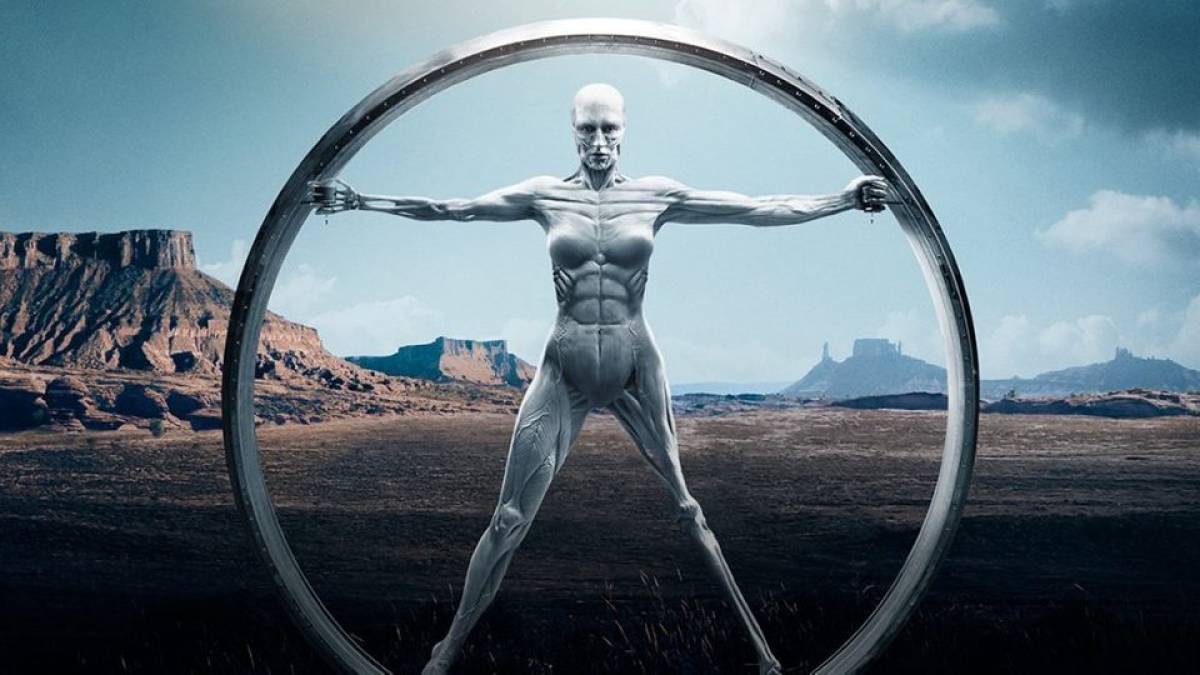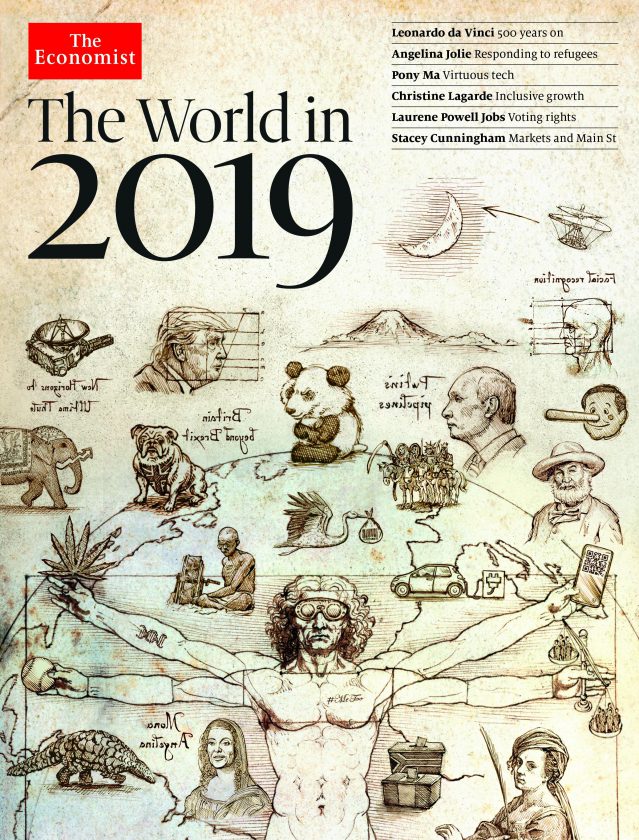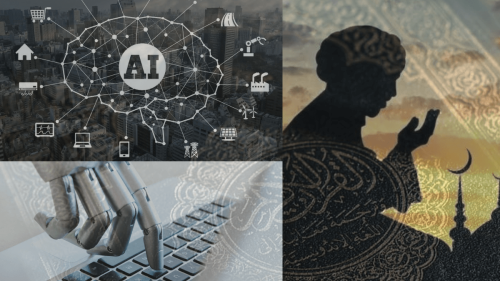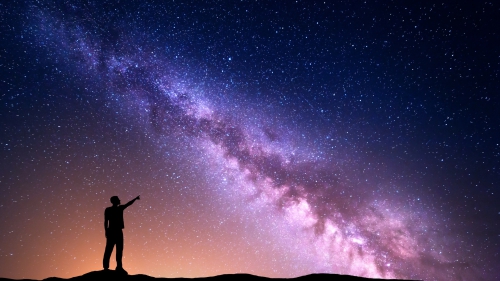Renaissance Humanism to Silicon Valley's Post-Humanism

“Science without conscience is nothing but ruin to the soul”
(François Rabelais)
Lately, the world famous business magazine, The Economist, has received quite a bit of international media attention; and understandably so.
Indeed, close to the end of each year, going back decades, it publishes an eagerly awaited special edition, which predicts the major political, business and social trends and events of the year to come. But unlike in the past, the December 2018 issue titled “The World in 2019” distinguished itself by the most unique and interesting characteristic of having had two successive and enigmatic covers. In the span of a few days, the cover photo of the 33rd edition of this magazine—partly-owned by the Rothschild family and reputed mouthpiece for the world’s elite and its global agenda[2]—went from all black color to almost black magic!
And since the magazine’s official website is of no help in deciphering the enigmas of these two covers—more particularly the second version which displays a broad spectrum of cryptic images and symbols—one is left with the uncomfortable need to have recourse to esoteric, occult and Masonic readings. Happily enough, an illuminating description of those mostly apocalyptic and Illuminati symbols has been provided in an eye-opening article[3] on the website of The Vigilant Citizen whose motto is the quote attributed to Confucius: “Signs and symbols rule the world, not words nor laws.”
At the center of the cover stands the “Vitruvian Man”, one of the most important artistic masterpieces—besides the Mona Lisa painting—of Leonardo da Vinci, a genius albeit mysterious figure of the Renaissance era, whose 500th death anniversary is expected to be commemorated, with all pomp and circumstance, in numerous Western countries in 2019 precisely.
In describing this main feature as posted by The Economist, the website explains that the “modern” Vitruvian Man “wears night-vision goggles, or maybe a VR headset […] In his hands, he holds a leaf of cannabis, a baseball, and a Smartphone. One could argue that all of these things are used to distract and pacify the modern man through drug companies, big tech, and entertainment. The Vitruvian Man also has two tattoos. On his forearm is a double-helix, the symbol representing DNA. This is most likely a reference to the intense research in DNA modification happening in the private sector. Was the Vitruvian Man’s DNA altered?”

The article concludes with key observations from which two crucial questions are raised: “Overall, the modern Vitruvian Man appears to be blinded, weakened, distracted, and repressed. The circle around him that once symbolized the spiritual realm is now the Earth. Did the Vitruvian Man lose his soul? Is he now concerned only with Earthly matters?”
It is worth noting that this Da Vinci’s drawing (circa 1490) was largely inspired by the works of Marcus Vitruvius Pollio, a famous ancient Roman architect, civil and military engineer, and author. In his treatise[4], translated from Latin as “Ten Books On Architecture”, Vitruvius showed that the “ideal” human body fitted precisely into a circle and a square—two fundamental geometric patterns of the cosmic order—thus illustrating the link that he believed existed between perfect geometric forms and the perfect body. More significantly, Vitruvius is considered to be among the most important “Grand Masters” and a central character—in addition to King Solomon of Israel, King Hiram of Tyre, and Hiram Abif, three Biblical figures closely associated with the construction of King Solomon’s temple—of an allegory said to be presented during the third degree in Freemasonry[5] whose single most identifiable logo combines two instruments used in architecture: a square and a set of compasses joined together, often with the letter “G” in the center.
In Masonic symbolism[6], the compass, as a tool, draws a circle; being with no beginning and no end, it signifies the soul (spirit or eternity). As for the square, it draws a four-sided square; it is an age-old symbol of the body (physical and temporary) which epitomizes the material world with its four cardinal points, four seasons, four elements and four states of matter. When placed together, however, they symbolize what is purportedly the ultimate goal of Freemasonry. That is, by squaring the circle—or harmonizing the opposite physical and spiritual world—to create the “perfect man”, and thus achieving godhood! It is no wonder then that Freemasonry is “open to men of any faith, but religion may not be discussed at Masonic meetings.”[7]
Isn’t The Economist’s new Vitruvian Man the same imaginary man as Friedrich Nietzsche’s Übermensch? The same “Beyond-man”, “Overman”, or “Superman” who was nowhere to be found neither by Zarathustra nor by his German philosopher disciple, and who ultimately drove the latter to insanity and death?[8] And is it not that exact same foolish, if not suicidal, quest that is still being sought—with yet more stubbornness and infinitely deeper scientific knowledge and more powerful technological means—in many laboratories across the “Silicon Valleys” of the “developed” world?
In his particularly frightening book—“highly recommended” by Bill Gates—Nick Bostrum[9], a Swedish philosopher and founding director of the Future of Humanity Institute at the University of Oxford, points out that if some day we build machine brains that surpass human brains in general intelligence, then this new super-intelligence could become very powerful. And “as the fate of the gorillas now depends more on us humans than on the gorillas themselves, so the fate of our species would depend on the actions of the machine super-intelligence”. He and many other Trans-humanists view trans-humanism as an extension of humanism, from which it is partially derived, and wish to follow life paths, which would, sooner or later, require growing into post-human persons. They yearn “to reach intellectual heights as far above any current human genius as humans are above other primates; to be resistant to disease and impervious to ageing; to have unlimited youth and vigor; to exercise control over their own desires, moods, and mental states; to be able to avoid feeling tired, hateful, or irritated about petty things; to have and increased capacity for pleasure, love, artistic appreciation, and serenity; to experience novel states of consciousness that current human brains cannot access.”[10]
In such a wondrous techno-geeking world wholly and exclusively devoted to the pursuit of individual leisure, sensual impulses and musings, Post-humans “could be completely synthetic artificial intelligences, or they could be enhanced uploads, or they could be the result of making many smaller but cumulatively profound augmentations to a biological human. The latter alternative would probably require either the redesign of the human organism using advanced nanotechnology or its radical enhancement using some combination of technologies such as genetic engineering, psychopharmacology, anti-aging therapies, neural interfaces, advanced information management tools, memory enhancing, drugs, wearable computers, and cognitive techniques.”[11] Nevertheless, the changes required to make us post-human are deemed too profound to be achievable by merely altering some aspects of psychological theory or the way we think about ourselves; that is why, radical technological modifications to our brains and bodies are needed.
Obviously, Trans-humanists are well aware that the coming technological transitions may be the most important challenge that humanity will ever face. They even admit that the entire future intelligent life on Earth may depend on how such transitions will be handled. If we do the right things, they say, a “wonderful post-human future with limitless opportunities for growth and flourishing may lie ahead”. Yet, they warn that if we handle them badly, “intelligent life may go extinct”. Bostrom believes that, in principle, we could build a kind of super-intelligence that would protect the human values. But in practice, he hastens to add, the control problem—the problem of how to control what super-intelligence would do—looks quite difficult, although it seems we will only get one chance. Be it as it may, he warns that once “unfriendly” super-intelligence exists, it would prevent us from replacing it or changing its preferences. As a result, “our fate would be sealed”![12]
To all those who are inclined to dismiss out of hand an “artificial takeover” as mere science fiction, Trans-humanists retort that it is likely that it will happen sometime in this century. And as a way of further persuading us of the correctness of their viewpoints and predictions, they consistently and conspicuously exhibit the data provided by Derek Price[13] according to whom at least since the late 19th century, science and technology, as measured by a wide range of indicators, have doubled about every 15 years. Extrapolating this exponential rate of progress, absent an abrupt reversal of current trends or an unexpected deceleration, Trans-humanists foresee dramatic changes in the relatively near future, and no longer hesitate to proclaim Urbi et Orbi the advent, at last, of the Modern Prometheus!
As a matter of fact, the countdown—tantamount to the point of no return—to Mary Shelley’s Frankenstein is on. Unsurprisingly, it has begun in Bostrum’s native Sweden where tech company BioHax International has already “microchipped” many of its employees.[14] The future has also arrived for employees of Wisconsin-based tech company Three Square Market (32M). The tiny chip, the size of a grain of rice—the same chip used in a credit card or mobile phone—is inserted between their thumb and index finger. It uses Radio-Frequency Identification or RIFD technology and allows employees to operate copy machines, open doors, login to computers and more, simply with the wave of a hand, without the traditional pass card.[15]
And as the saying goes, the “best” is yet to come, on two fronts: Firstly, on the corporate level, a fierce competition is underway in the different “Silicon Valleys” around the world. It is more often than not fueled by the unbridled imagination, material greed and will to power that motivate some executives like Mark Zuckerberg and Elon Musk.[16]In the United States, considered the world leader in Artificial Intelligence (AI) and machine learning, engineers and neuro-scientists have been working quietly, for over two decades, to build a revolutionary technology called BrainGatethat wirelessly connects the human mind to computers by means of chipping people’s brains. They are already in the process of digitally mapping the human brain. And they are experimenting with, and changing in a significant way, human behavior and brain function.[17] Secondly, on the global level, relentless efforts are being made and considerable financial resources poured into the race for world leadership in AI, with a particular emphasis on its military applications, of which the development of Lethal Autonomous Weapon Systems. The latter issue is so acute and challenging that it prompted the United Nations to initiate a debate on a treaty banning such nightmarish weapons.[18] Russian President Vladimir Putin put it bluntly when he declared that “Artificial intelligence is the future, not only for Russia, but for all humankind. It comes with colossal opportunities, but also threats that are difficult to predict. Whoever becomes the leader in this sphere will become the ruler of the world.”[19] Reacting to Putin’s remarks, Elon Musk said that competition for AI superiority at national level will be the “most likely cause of WW3”. He clarified that he believes the war would be started not by a world leader, but by an AI as a preemptive strike.[20]
This dramatic evolution and its deep impact on the sustainability of modern civilization will be the main topic of a forthcoming analysis.
* * *
Amir Nour is an Algerian researcher in international relations, author of the book L’Orient et l’Occident à l’heure d’un nouveau Sykes-Picot (“The Orient and the Occident in time of a New Sykes-Picot”), Editions Alem El Afkar, Algiers, 2014: downloadable free of charge, by clicking on the following links:http://algerienetwork.com/blog/lorient-et-loccident-a-lheure-dun-nouveau-sykes-picot-par-amir-nour/ (French)
http://algerienetwork.com/blog/العالم-العربي-على-موعد-مع-سايكس-بيكو-ج/ (Arabic)
- N/A
- The magazine’s former Editor-in-Chief (2006-2015) is none other than John Micklethwait who has attended several times the secretive Bilderberg Conferences and contributed to their publicly undisclosed discussions and outcomes. See the list of participants to (https://bilderbergmeetings.org.participants.html) and main topics of (https://cnbc.com/2018/06/06/bilderberg-meeting-elite-focuses-on-politics.html) the 2018 Bilderberg meeting, held in Turin (Italy) in June 2018. ↑
- Read: https://vigilantcitizen.com/vigilantreport/the-economists-the-world-in-2019-is-full-of-cryptic-messages/ ↑
- Marcus Vitruvius Pollio, De Architectura Libri Decem, written circa 20-30 BC and “rediscovered” in 1414 by the Italian “humanist” Poggio Bracciolini in the Abbey of St Gallen, Switzerland. ↑
- A Masonic lodge called Vitruvius Lodge # 145 was established in 1860 and still operates in Bloomfield, CA. ↑
- Richard Cassaro, What Does the Freemason’s ‘Square&Compass’ Symbol Really Stand For?richardcassaro.com, November 28, 2009. ↑
- See Statement on Freemasonry and Religion, Masonic Service Association of North America. ↑
- According to a study published in Acta Psychiatrica Scandinavia, in December 2006, Nietzsche’s death was not due to General Paralysis of the Insane (GPI), as commonly thought for a long time, but rather to Frontotemporal Dementia (FTD) which is a chronic dementia. ↑
- Nick Bostrum, Superintelligence: Paths, Dangers, Strategies, Oxford University Press, 2014. ↑
- Read Transhumanist FAQ, version 3.0 in https://whatistranshumanism.org ↑
- Idem, Op.cit. ↑
- Nick Bostrom, Op.cit. ↑
- Derek J. de Solla Price, Little Science, Big Science…and Beyond, Columbia University Press, 1988. ↑
- Jonathan Margolis, I am microchipped and have no regrets, The Financial Times, May 8, 2018. ↑
- Haley Weiss, Why You’re Probably Getting a Microchip Implant Someday, The Atlantic, Sept. 21, 2018. ↑
- Co-founder of American neurotechnology company Neuralink, which is reported to be developing implantable Brain-Computer Interfaces (BCIs). ↑
- Jeff Stibel, Hacking The Brain: The Future Computer Chips In Your Head, Forbes.com, July 10, 2017. ↑
- See 2017 UN report: https://daccess-ods.un.org/TMP/6036958.69445801.html ↑
- RT, Whoever leads in AI will rule the world: Putin to Russian children on Knowledge Day, Sept. 1, 2017. ↑
- Karla Lant, Elon Musk: Competition for AI Superiority at National Level Will Be the “Most Likely Cause of WW3”, Futurism, September 4, 2017. ↑
( Source: The Saker )
Topics: Artificial Intelligence, Humanity, Modern Science, Soul (Nafs)
Views: 1784
Related Suggestions

















